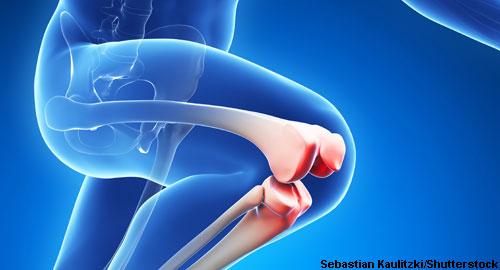 When non-surgical approaches fail to help patients address the pain and impaired mobility that can result from rheumatic disease, patients with joint damage may turn to joint replacement surgery. In fact, joint replacement surgery has become one of the more common surgeries in the U.S. A 2015 prevalence study of joint replacement surgeries between 1996 and 2010 found that more than 4.7 million living Americans had undergone a total knee replacement, also known as total knee arthroplasty, and 2.5 million Americans had had a total hip arthroplasty, according to the study’s lead investigator Daniel Berry, MD.1
When non-surgical approaches fail to help patients address the pain and impaired mobility that can result from rheumatic disease, patients with joint damage may turn to joint replacement surgery. In fact, joint replacement surgery has become one of the more common surgeries in the U.S. A 2015 prevalence study of joint replacement surgeries between 1996 and 2010 found that more than 4.7 million living Americans had undergone a total knee replacement, also known as total knee arthroplasty, and 2.5 million Americans had had a total hip arthroplasty, according to the study’s lead investigator Daniel Berry, MD.1
Dr. Berry is an orthopedic surgeon at the Mayo Clinic in Rochester, Minn., and provides joint replacement surgery for a high number of patients with rheumatoid arthritis (RA).
“Pain relief is the No. 1 surgical outcome we are going after, but in a great majority of patients, we also want to see improved function,” Dr. Berry notes.
He clarifies that function does have limitations, such as mobility related to other joints that may be affected by RA. Dr. Berry measures both pain and mobility in joint replacement surgical patients through composite scores. He also advocates that hospitals and surgeons submit outcome data for arthroplasty to the American Joint Replacement Registry. “These data provide a clear measure for the expected outcomes a patient and rheumatologist can consider,” Dr. Berry says.
Patient-reported outcome measures are also critical data points to consider, because patients may view measures of a good outcome differently than a surgeon. Dr. Berry adds, “Both perspectives are important for patients and their providers to review as they explore surgical options.”
A 2016 study showed that patients considering joint surgery evaluate seven key decisions, including whether to have surgery and selecting a surgery date, surgeon, facility and implant device, as well as the availability of healthcare professionals and homecare services. The study also showed that patients’ trust and communication with doctors was the most commonly used factor when choosing an arthroplasty surgeon.2
4 Strategies for Surgical Success
Special considerations should be taken to establish realistic surgical goals and stay ahead of surgical complications RA patients may be at increased risk of experiencing, such as postoperative infection and challenges with rehabilitation caused by other problematic joints, Dr. Berry acknowledges. He says, “Good communication between the surgeon and patient starts well before surgery and carries on well after surgery.”
Dr. Berry employs four strategies to help patients with RA achieve their best surgical outcomes and mitigate the risks of complications:
- Select the correct patients: Identify patients who can achieve benefits, such as pain reduction and improved mobility, that outweigh risks of surgery;
- Optimize preoperative evaluation: Ensure patients are checked medically prior to surgery so any underlying concerns or comorbidities can be addressed and accounted for, minimizing problems around time of surgery;
- Establish realistic expectations: Identify and agree on specific problems that surgery can address, sharing the best, average and worst case scenarios that the patient may encounter after surgery and allowing the patient to weigh the risks vs. benefits well before surgery; and
- Use intraoperative approaches that reduce infection risk: Make a plan for suspending and restarting immunosuppressant agents to reduce the risk of developing a postoperative infection. For patients at high risk of infection, use antibiotic-impregnated bone cement, optimize perioperative antibiotics and manage wound closure to minimize infection risk. Agents designed to minimize bleeding may also be used as part of these measures to minimize early postoperative complications so recovery can progress as planned.
The Rheumatology Perspective
Dr. Berry stresses the value of close collaboration and frequent communication between a patient’s surgeon, rheumatologist and physical therapist to optimize postoperative care. Jeffrey Katz, MD, a rheumatologist and professor of orthopedic surgery and medicine at Brigham and Women’s Hospital in Boston, agrees with Dr. Berry that collaborative communication can make a significant difference in a patient’s recovery.
Dr. Katz says any patient considering surgery should coordinate with their rheumatologist to find the best fit for a surgeon familiar with their rheumatic disease. It’s also important that the surgeon operates in a surgical facility in which a high volume of total joint surgeries are annually performed.
Medication management is an important care element for collaborative discussion, particularly if the patient is on an immunosuppressant that will need to be suspended prior to surgery and restarted after surgery at a point that won’t delay the healing of the operative sight. Dr. Katz says, “During medication therapy suspension, flare-ups may be more likely to occur and could compound the pain a patient experiences after surgery.”
Postoperative pain management medication should be closely planned, particularly because some frail patients with rheumatic diseases may not tolerate non-steroidal anti-inflammatory drugs. Opiates are typically prescribed after joint replacement surgery, according to Dr. Berry and Dr. Katz, but they stress that responsible management of opiates should be considered in relation to the patient’s pain.
In terms of expected outcomes, Dr. Katz is particularly interested in patients with osteoarthritis who also commonly undergo joint replacement and may achieve pain relief, but no improvement in physical activity. He says one question rheumatologists and surgeons are investigating is how to get these patients moving most effectively after surgery.
Physical Therapy Options
In addition to addressing long-term postoperative goals, Dr. Katz and Dr. Berry stress the importance for carefully orchestrated postoperative physical therapy immediately after surgery. They suggest this therapy should take into account unique challenges that a patient with a rheumatic disease may experience. Example: Having a patient use a walker or cane after surgery can put strain on inflamed and damaged wrist joints.
That’s why physical therapist Maura Daly Iversen, DPT, MPH, PT, SD, suggests the physical therapist meet with a surgical patient before surgery. Dr. Iversen is a professor and chair in the Department of Physical Therapy, Movement and Rehabilitation Sciences at Northeastern University in Boston.
“It’s important for patients to have clear expectations for what postoperative therapy will involve and work with their physical therapist ahead of time to establish a plan for specialized walkers or other assistive devices the patient can get used to using before surgery,” Dr. Iversen explains.
She is also a strong advocate for preoperative physical therapy to help patients recover faster after surgery, an approach supported by research she has conducted. In one study, exercise participation prior to total joint arthroplasty substantially reduced the risk of patients being discharged to a rehabilitation facility after surgery.3
“We know if you train before surgery you can improve outcomes. The surgical approach for both hips and knees does affect muscles, but if the muscles are strong, the patient will recover faster,” Dr. Iversen says. “That’s why preoperative physical therapy can be an important consideration to maximize function.”
Because patients with joint replacements are often discharged just two to three days after surgery, Dr. Iversen cautions that physical therapy needs to be planned early to avoid a gap in the provision of care that can increase the risk for the patient to lose movement and strength. “If a patient has a relationship with their physical therapist before the surgery, this is ideal.”
Carina Stanton is a freelance science journalist based in Denver.
References
- Kremers HM, Larson DR, Crowson CS, et al. Prevalence of total hip and knee replacement in the United States. J Bone Joint Surg Am. 2015 Sept 2;97(17):1386–1397. doi:10.2106/JBJS.N.01141.
- Nowell WB, Venkatachalam S, Harden E, et al. Patient decisions related to hip and knee arthroplasty and the factors influencing them [abstract]. Arthritis Rheumatol. 2016 Oct;68(suppl 10).
- Rooks DS, Huang J, Bierbaum BE, et al. Effect of preoperative exercise on measures of functional status in men and women undergoing total hip and knee arthroplasty. Arthritis Care Res. 2006 Sept;55(5):700–708. DOI:10.1002/art.22223.


